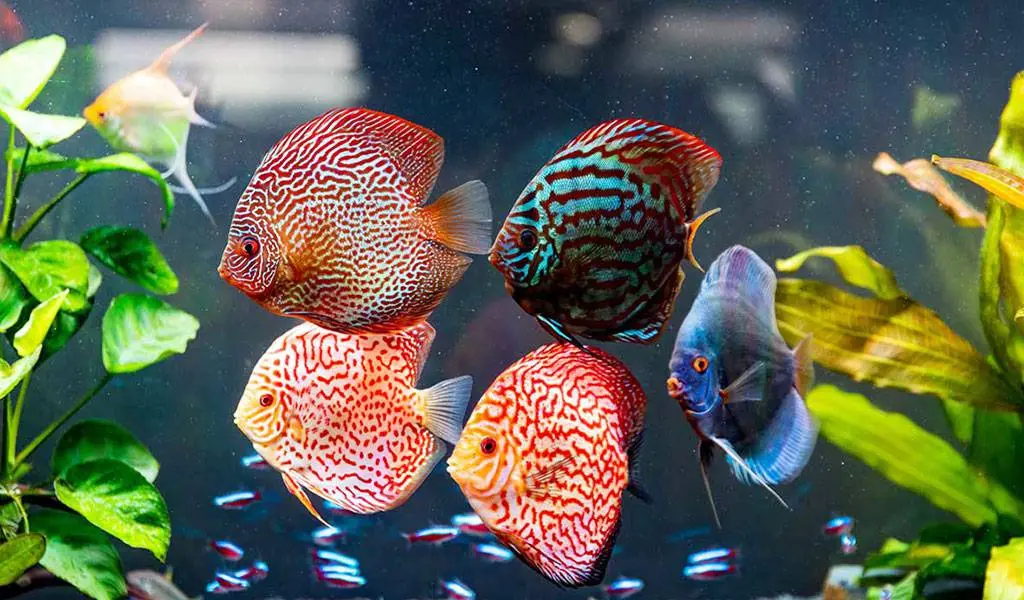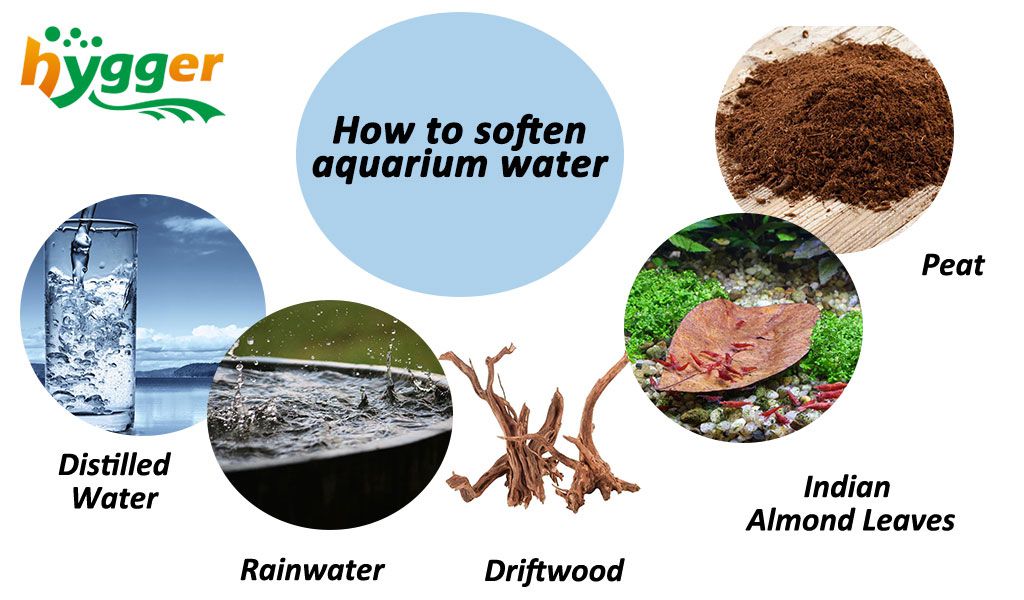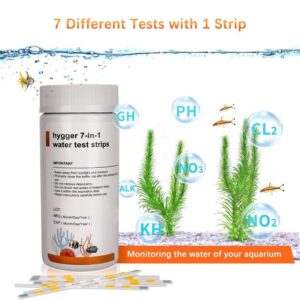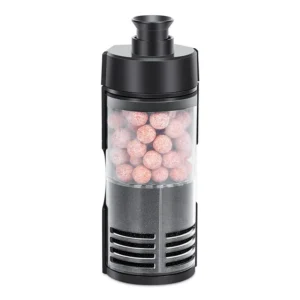Do you know some fish are fond of hard water, while others prefer soft water? However, sometimes soft water may become hard as the aquarium’s living conditions change. Accordingly, this article will walk you through some methods about how to soften water for aquariums naturally. So let’s get started right away.
Content Table
What is soft water in aquariums
GH & KH
To begin with, let’s learn something about water hardness, which includes GH and KH. GH, also called general hardness, means the levels of calcium and magnesium in the water. General hardness is the reason for limescale forming on the aquarium lids and glass. On the other side, KH, also named carbonate hardness, refers to the levels of carbonate and bicarbonate in the water.
Though GH (general hardness) and KH (carbonate hardness) measure the water hardness, they are different exactly. GH does not influence the pH level, while KH directly affects the pH level. Generally, the higher the KH, the higher the pH level. For instance, adding Indian almond leaves or catappa leaves would decrease the pH level and KH in the water, then the water turns more acidic, but the GH is unchanged. Therefore, you should know which one you need to reduce – GH or KH.
Aside from that, there is more you need to learn about water hardness.
| Units of GH or KH | |
| GH (general hardness) | ① dGH (degrees of general hardness) ② ppm (parts per million, 1 dGH=17.9 ppm or 17.9 mg/L) |
| KH (carbonate hardness) | ① dKH (degrees of carbonate hardness) ② ppm (parts per million, 1 dKH=17.85 ppm or 17.85 mg/l calcium carbonate) |
Aquarium water hardness – Soft water & Hard water
Additionally, how to tell if the aquarium water is hard or soft? Specifically, hard water comes with a high pH level because of its high mineral content. While the pH level of soft water is usually low, due to the low mineral content. In general, hard water tends to be more alkaline, and soft water is more acidic. Next, we will list some general values of hard and soft water.
- Hard water: more than 12 dGH/more than 210 ppm
- Moderately hard water (8-12°GH/140-210 ppm)
- Soft water: 4-8 dGH/70-140 ppm
- Very soft water: 0-4 dGH /0-70 ppm
However, these values are just references. They are not definitive answers. Generally, the 4-8 dGH or 70-140 ppm is suitable for most freshwater fish tanks, the 3-15 dGH is ideal for most planted aquariums, while the 4-12 dKH is good for most freshwater planted aquariums.
Fish need soft water
Next, we will list some fish demanding soft water.
| Fish | pH level | Water hardness |
| Discus Fish | 5.0-7.0 | 4-8 dGH |
| German Blue Ram | 5.0-6.0 | 6-14 dGH |
| Glowlight Tetras | 5.5-7.0 | Up to 15 dGH |
| Cardinal Tetras | 5.0-6.0 | Up to 4 dGH |
| Angelfish | 6.0-8.0 | 2-8 dGH |
| Clown Loach | 6.5-7.5 | 5-15 dGH |
| Pearl Gourami | 6.0-8.0 | 2-30 dGH |
| Corydoras Catfish | 6.5-7.8 | 6-12 dGH |
| Betta fish | 6.5-8.0 | 5-20 dGH |
| Harlequin Rasboras | 6.0-7.8 | 2-15 dGH |
| Zebra Danios | 6.5-7.2 | 5-19 dGH |
| Rainbow fish | 7.0-8.0 | 4-10 dGH |

How to soften aquarium water
In this segment, we will cover methods of how to soften water in aquariums.
Change water
1. Rainwater
(1)Roles of Rainwater
- Lower GH and KH
- Lower pH level
(2)How To Do
Mix the rainwater with tap water. Then refill the aquarium.
(3)Pros and Cons of Rainwater
Pros:
- Lower cost or even free
- Mixing it with tap water to lower GH and KH
- Lower the pH level under 7.0
Cons:
- Not ideal for regions of rainwater deficiency
- Consume time and energy to collect and store rainwater
2. Distilled water
(1)Roles of Distilled Water
- Lower GH and KH
- Lower pH level
(2)How To Do
Mix the distilled water with tap water, then refill the aquariums.
(3)Pros and Cons of Distilled Water
Pros:
- Available in stores
- Distilled water is purified to neutral with a pH level of 7.0
Cons:
- Higher cost
3. RO/DI water (Reverse Osmosis water/Deionization water)
(1)Roles of RO/DI Water
- Lower GH and KH
- Lower pH level
(2)How To Do
Mix the RO/DI water with tap water, then refill the aquarium.
(3)Pros and Cons of RO/DI Water
Pros:
- The degrees of GH and KH for RO or DI water is zero
- The pH level of RO or DI water is about 7.0
- No need to store the water
Cons:
- The high cost (expensive RO/DI system)
- Waste of water
- For large aquariums, it consumes time to purify water
Driftwood
(1)Roles of Driftwood
- Lower KH
- Lower pH level
(2)How To Do
Add driftwood to the aquarium, just like aquarium decorations.
(3)Pros and Cons of Driftwood
Pros:
- Tannin helps to enhance the immune system of fish, which is beneficial against fungal infection
- Available in pet stores
Cons:
- Watercolor turns brown: brown tannin leached from the driftwood will make the watercolor brown, but it is not damaging to fish
- Risk of introducing parasites to your tank
Indian Almond Leaves
(1)Roles of Indian Almond Leaves
- Lower KH
- Lower pH level
(2)How To Do
Rinse, soak, or boil the Indian almond leaves before adding them to aquariums. Commonly, one leaf or two leaves for every 10 gallons of water.
(3)Pros and Cons of Indian Almond Leaves
Pros:
- Ideal for shrimp aquariums, like Caridina shrimp (e.g. Crystal shrimp, Tiger shrimp, and bee shrimp)
- Tannin helps to enhance the immune system of aquatic pets, which is beneficial against fungal infection
- A food source for shrimps
- Do not affect GH
Cons:
- Watercolor turns brown: brown tannin leached from the leaves will make the watercolor brown, but it is not damaging to the pets
- Not an excellent option for tanks larger than 20 gallon
Peat
(1)Roles of Peat
- Lower KH
- Lower pH level
(2)How To Do
Place the peat in a mesh bag, and then put it into the aquarium filter.
(3)Pros and Cons of Peat
Pros:
- A great alternative for large tanks
- Tannin helps to enhance the immune system of fish, which is beneficial against fungal infection
- Do not affect GH
Cons:
- Watercolor turns brown: brown tannin leached from peat will make the watercolor brown
Relevant topic
In short, just test the aquarium water regularly and determine the real-time water condition. Then adjust the water parameters according to the tank size and status. By the way, you can go to Aquarium Water Sources – The Best Water for Aquarium to know more about aquarium water.



Leave a comment